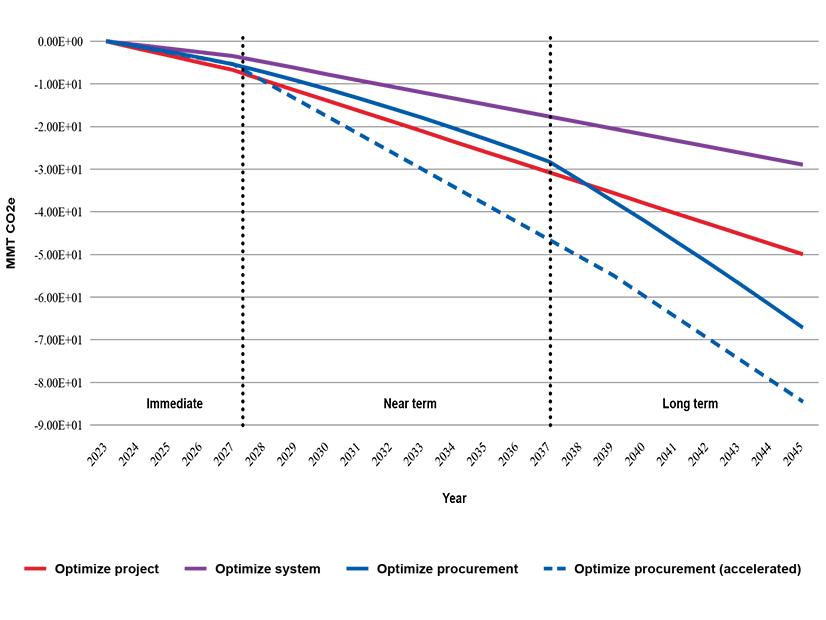California needs both building-focused and material-focused approaches to driving down the embodied carbon in new construction if it is to reach its net zero goals, according to a new study.
California needs both building-focused and material-focused approaches to driving down the embodied carbon in new construction if it is to reach the state’s net zero goals, according to a new study.
Policies such as state and local building codes requiring low-carbon materials need to be adopted along with strategies such as reusing existing buildings and minimizing new construction, the Embodied Carbon Reduction Roadmap report, authored by Arup, a sustainable development consultancy, for the Natural Resources Defense Council (NRDC) found.
The study quantified the reduction potential of strategies for new residential and commercial construction in California and the state’s ability to meet its 2045 net zero goal under Executive Order B-55-18, or its more aggressive 2035 net zero goal under AB 2446. The study focused on California “due to its capacity, leverage and track record for lowering barriers and risks for others in the nation and around the world.”
A building’s embodied carbon is the emissions related to materials extracted, processed and transported to the site as well as generated by the construction process and its end of life. It does not include emissions related to operating the building, which are about three times the embodied energy over a building’s lifetime, according to a study on reducing embodied carbon emissions in the building construction sector released last week. (See New Buildings May be the Next Climate Solution.)
The NRDC report grouped embodied carbon reduction strategies for buildings by those that optimize reductions at the project level, in the building systems or at the materials procurement level. “A building-focused approach uses whole building life-cycle assessment to evaluate performance. A material-focused approach uses environmental product declarations to evaluate performance.”
The study found that in the near term, optimizing the project provided the greatest opportunity to reduce the embodied carbon of buildings, while in the long term, optimizing the building materials procured made the biggest impact. However, if new, lower-carbon materials are brought to market more quickly, then optimizing procurement will make the biggest impact in the near term as well.
The highest impact strategy to cut buildings’ embodied carbon is to use low-carbon concrete, though no single strategy will enable the state to reach its net zero goals. Minimizing new construction, reusing buildings and buying low-carbon steel and insulation are the next most effective strategies to reduce new construction’s Global Warming Potential (GWP).
As far as policies go, those that encourage clean procurement have a larger impact than building codes, though both are substantially bigger levers than zoning, climate commitments, training and education or waste and circularity policies.
Local Policies Vital
The report called for more policies to encourage design and construction practices that lower whole-building emissions.
“While many emerging policies address material-level carbon performance, it is recommended that more focus goes into policies that encourage project- and building-scale reductions. This study has shown the gap and opportunity of policies focused on planning and design of whole buildings. Advancing building-focused policy approaches at the same time as materials-focused approaches would accelerate the buildings sector towards a zero-carbon future.” the report said.
It’s not just state-level policies that are important; city and county policies can be critical to driving building improvements and can play a role in raising the bar. In 2019, Marin County was the first local jurisdiction in California to adopt embodied carbon requirements in its base building code amendments, and since then, other jurisdictions have adopted code amendments and “stretch codes” that go even further, such as requiring all-electric new construction. California has approved building changes to include mandatory embodied carbon requirements in the state’s green building code, CALGreen, which should go into effect in 2024.
“Policies impacting building embodied carbon are vast and applied ranging from the hyper-local level to the state level. Some policy types more directly prescribe embodied carbon performance, while other policy types have indirect impacts to embodied carbon. The broad range of policies presents both a challenge and opportunity, in that multiple levers can be explored to enact change.”
Policies requiring the use of lower-carbon materials impact both public and private developments, and while they influence a building’s design, often it is the contractor who is responsible for procuring materials that conform with the policy, the report noted.

